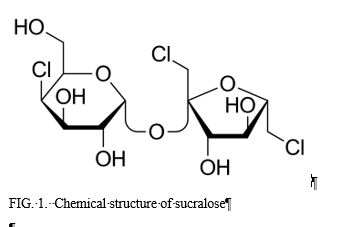DURHAM, N.C. & RALEIGH, N.C. - Aug. 23, 2018 - PRLog -- Breaking News:
The artificial sweetener sucralose is metabolized and accumulates in fat tissue.
A study just published in the Journal of Toxicology and Environmental Health, Part A contradicts claims by the chemical sweetener industry that the artificial sweetener sucralose is safe because it quickly passes through the body unchanged. This claim was pivotal for gaining approval from regulatory agencies, including the US FDA for the addition of the chlorinated chemical sucralose to the food supply. However, an independent research laboratory with expertise in food quality and food safety testing, Avazyme Inc. in Durham, NC, in collaboration with researchers at North Carolina State University, have found that sucralose is indeed metabolized in the intestines. Furthermore, the research team also found that sucralose accumulates in fat tissue after prolonged exposure. Dr. Volker Bornemann and his team at Avazyme have many years of experience in studying xenobiotic metabolism and utilized state of the art ultra high-performance liquid chromatography (UHPLC) and mass spectrometry to analyze fecal, urine, and fat samples from test specimens, who were exposed to sucralose daily for an extended period of time. Dr. Bornemann noted: "At first, we did not see any difference to what other researchers had found before, when we replicated their methodology. Only after we used a different, more suitable extraction methodology and study design did we find that sucralose had actually been metabolized to a significant extent, and also accumulated in the adipose fat over time. These sucralose metabolites had never been reported before." One of his co-authors, Dr. Susan Schiffman, concludes: "The important data and findings obtained in this study raise serious new concerns about food safety, and strongly demonstrate that it is now time to revisit the regulatory status of sucralose."
The entire study can be accessed at: https://www.tandfonline.com/doi/full/10.1080/15287394.2018.1502560
For additional information, please contact:
Dr Volker Bornemann e-mail: Media@Avazyme.com
Dr. Susan S. Schiffman e-mail: ssschiff@ncsu.edu
ABSTRACT:
Intestinal Metabolism and Bioaccumulation of Sucralose in Adipose Tissue in the Rat
Volker Bornemann, Stephen C. Werness, Lauren Buslinger & Susan S. Schiffman
Received 30 May 2018, Accepted 16 Jul 2018, Published online: 21 Aug 2018
Sucralose paper link
https://www.tandfonline.com/doi/full/10.1080/15287394.2018.1502560
The aim of this study was to (1) determine if the organochlorine artificial sweetener sucralose is metabolized in rat intestine with repeated dosing and (2) examine whether sucralose might bioaccumulate in rat adipose tissue. Sucralose was administered to 10 rats by gavage daily for 40 days at an average dosage of 80.4 mg/kg/day. The dosages were within the range utilized in historical toxicology studies submitted for regulatory approval in North America, Europe, and Asia. Feces and urine were collected individually from each animal for every 24-hr period during the 40-day dosing period. Analysis of the urine and fecal extracts by ultra-high performance liquid chromatography tandem mass spectrometry (UHPLC–MS/MS) revealed two new biotransformation products that have not previously been reported. These two metabolites are both acetylated forms of sucralose that are less polar and hence more lipophilic than sucralose itself. These metabolites were present in urine and feces throughout the sucralose dosing period and still detected at low levels in the urine 11 days after discontinuation of sucralose administration and 6 days after sucralose was no longer detected in the urine or feces. The finding of acetylated sucralose metabolites in urine and feces do not support early metabolism studies, on which regulatory approval was based, that claimed ingested sucralose is excreted unchanged (i.e. not metabolized). The historical metabolic studies apparently failed to detect these metabolites in part because investigators used a methanol fraction from feces for analysis along with thin layer chromatography and a low-resolution linear radioactivity analyzer. Further, sucralose was found in adipose tissue in rats two weeks after cessation of the 40-day feeding period even though this compound had disappeared from the urine and feces. Thus, depuration of sucralose which accumulated in fatty tissue requires an extended period of time after discontinuation of chemical ingestion. These new findings of metabolism of sucralose in the gastrointestinal tract (GIT) and its accumulation in adipose tissue were not part of the original regulatory decision process for this agent and indicate that it now may be time to revisit the safety and regulatory status of this organochlorine artificial sweetener.
Contact
AVAZYME, INC. Suzanne Bornemann
Director of Marketing
media@avazyme.com
Photos: (Click photo to enlarge)


Read Full Story - Breaking News! The artificial sweetener Sucralose is metabolized and accumulates in fat tissue | More news from this source
Press release distribution by PRLog

